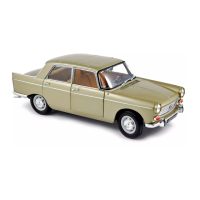springs, taking care not to damage the
rubber
seal on the
inner
piston.
When
fittrng
the springs make sure that the
straight end which
goes
through the
pin.
is
positioned
inward
facing
the
rubber seal
and
the round
end
outward
away f rom the seal.
Check that the bleed screws are tight, then
operate
the
brake
pedal
several times until a
solid resistance is felt,
this wrll
indicate that
any
gaps
between
piston
and
pad
or
pad
and
disc have been taken up.
Check
the fluid level in the reservoir and top up iÍ
necessarv with
Lockheed 43..
Bleeding the brakes:
This
has
already
been described
in
Section
1 0
:7
and
the
procedure
when disc brakes are
fitted remains the
same.
lf when
bleeding the
rear
brakes
the
pedal
suddenly
becomes
'hard',
this indicates
that
the
brake
pressure
regulator
has
become
operative usually due
to over
vigorous application of
the
pedal.
To
rectify
this con-
dition
proceed
as
follows:
Tighten up
the rear bleed screws and
Íelease the
hand
brake
with a sudden
jerk.
This will cause the rear shoes
to
move back
from the drums and
make a
return flow
of
fluid in the
pipes
which in turn causes the
pressure
limiter
ball
balve of the brake
regulator to
lift
off
its
seat,
Pull on the
hand brake again and continue
the bleeding
operailon.
When
bleeding the ÍÍont
brakes
in
order to expel any
air
which
may have
been
trapped in
the bottom cylinoer.
complete the
bleeding as
Íollows:
Tighten
the bleed screw and hold
the
pedalfirmly
down
Íor
about
10 seconds then
slacken ofÍ the
bleed screw
without releasing
the
pedal.
Tighten
the screw
and
release the
pedal.
Repeat
until no more air
bubbles are
visible.
10 :9 Fault
diagnosis
(a)
'Spongy
pedal'
1
Leak
in
the system
2 Worn master cvlinder
3 Leaking wheel cylinders
4 Air in the
svstem
(b)
Excessive
pedal
movement
1
Check
1
and
4 in
(a)
2 Excessive lining
wear
3 Verv
low fluid level in reservoir
(c)
Brakes
grab
or
pull
to
one
side
1 Brake backolate loose
2
Scored,
cracked
or
distorted
drum
3 High spots on drum
4
Unbalanced shoe ad.iustment
5 Wet or oily
linings
6 Worn
steering connections
7 Front suspension
or
rear
axle anchorages loose
8
Mixed
linings
oÍ different
grades
9
Uneven tyre
pressures
1
0 Broken shoe return spÍings
1 1
Seized
handbrake
cable(s)
P404 93

